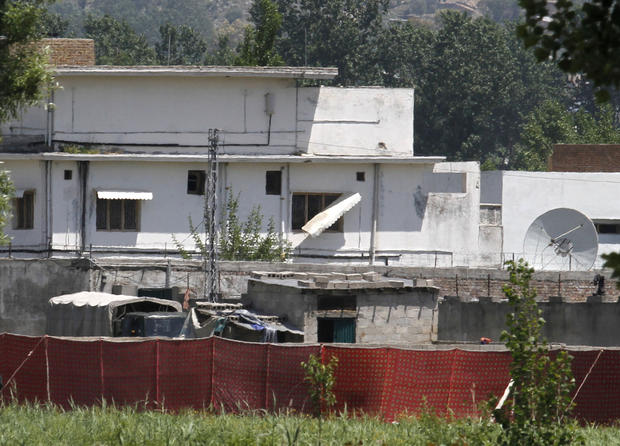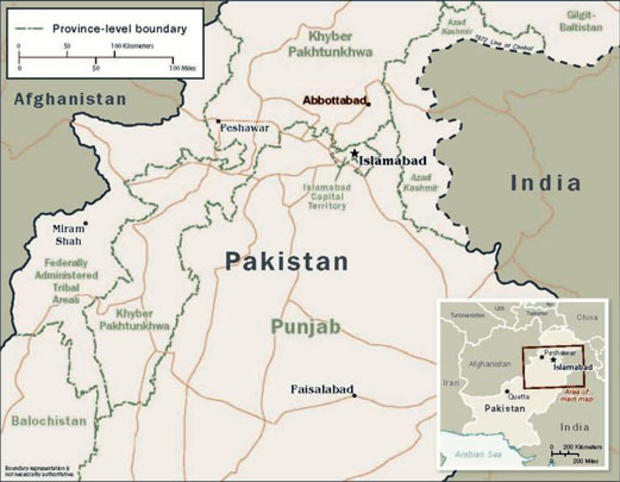To the bottom of the sea: Bin Laden's last day
Hours after receiving the go-ahead from President Barack Obama to perform a "surgical strike" on an expansive compound thought to house Osama bin Laden, helicopters descended out of the darkness into an affluent Pakistani neighborhood. Mr. Obama and his top advisers watched the action unfold in the Situation Room.
As the information from the operation flowed into the Situation Room on Sunday afternoon, the president exclaimed, "We got him."
One official heard a commander on scene say, "Geronimo E-KIA." Geronimo was the code name for Bin Laden; E-KIA is "enemy killed in action."
The hunt for bin Laden that ended Monday morning in Pakistan began years ago, when captured al Qaeda operatives first revealed the existence of bin Laden's most trusted courier. Some of the leads to the courier came out of the CIA's secret prisons, where high level al Qaeda captives were waterboarded.
CBS News correspondent David Martin reports that the courier was described as a protege of 9/11 mastermind Khalid Sheik Mohammed, and the man who delivered bin Laden's orders to al Qaeda operatives in the field. In fact, current and former U.S. officials said that Mohammed gave intelligence officials the courier's name. The CIA got similar information from Mohammed's successor, Abu Faraj al-Libi. Both were subjected to harsh interrogation tactics inside CIA prisons in Poland and Romania.
It was about four years ago that U.S. intelligence finally determined the courier's real name: Maulawi Abd al-Khaliq Jan. Take a look at it. It cost bin Laden his life.
Key to the hunt was identifying the cell phone number of the courier and placing it under surveillance. In 2010, the U.S. intercepted a call to the courier in which he was asked where he had been. He responded that he was back with the people he had been with before. The caller then said, "May God facilitate you" - the implication being that courier was back with bin Laden and his family.
The courier did not make it easy to locate the compound, however, since every time he approached the compound, he turned off his phone. He did this more than 90 minutes out and removed the battery, so he went totally dark and would leave it off when he was in the compound. When he left the compound, he would wait 90 minutes and turn it back on. Analysts would therefore keep seeing this pop up in places all over Pakistan but nowhere near to Abbattabod. This is why it took so long to find the compound after they had the name and the cell phone number for the courier.
It took another two years after identifying the courier to find out what part of Pakistan Maulawi Jan operated in. Then, last August, the CIA discovered his residence. Officials said they were shocked by what they saw.
White House: We would have taken bin Laden aliveObama's move "one of the gutsiest," adviser says
Obama monitored Osama bin Laden attack in real time
"This intelligence case is different. What we see in this compound is different from anything we've ever seen before," said John Brennan, White House counterterrorism advisor.
It was a $1 million compound, eight times bigger than any of the other homes, in a town where retired Pakistani military officers live, just 35 miles north of the capital of Islamabad.
It was built in 2005, apparently just for bin Laden, with walls as high as 18 feet, topped with barbed wire, the main building with opaque windows facing out and a seven-foot privacy wall on the third floor balcony. The residents of the compound burned their trash instead of putting it out for collection and despite the $1 million price tag, there was no telephone or internet service. Three families lived there: the courier's family, his brother's family, and a third family about the size of bin Laden's. It was a convincing but circumstantial case.
Pictures: Osama's hideaway
Pictures: Osama bin Laden
Pictures: Osama bin Laden killed - America reacts
Once US had located the compound where the courier lived, they put it under surveillance and noticed that every day a tall man emerged from the main house and walked for an hour around the courtyard. Imagery indicated that the man was between 5'8" and 6'5", but the photos were not good enough to make a positive identification. They were images from satellites and not drones, since location was too risky to deploy the unmanned aircraft.
Surveillance also indicated that the courier was living in the guard-house not the main house and that the "pacer" was living in the main house.
By mid-February, intelligence from multiple sources was clear enough that Mr. Obama wanted to "pursue an aggressive course of action," a senior administration official said. Over the next two and a half months, Mr. Obama led five meetings of the National Security Council focused solely on whether bin Laden was in that compound and, if so, how to get him, the official said.
President Obama considered attacking with B-2 stealth bombers flying non-stop from the U.S., but instead he chose the option that offered the best chance of coming away with proof bin Laden had been killed -- a helicopter raid by Navy SEALs.
It was also the riskiest option -- American commandos operating without permission deep inside Pakistani territory. The operation was such a tightly held secret that when the SEALs began training on a mockup of the compound, they were not told whom the real target was.
Video: Bin Laden compound, morning after raid
Video: Bin Laden operation planned for months
Video: Did Pakistan know bin Laden's location?
Video: Osama Bin Laden: How did they get him?
On April 29, Mr. Obama approved an operation to get bin Laden. It was a mission that required surgical accuracy, even more precision than could be delivered by the government's sophisticated Predator drones. To execute it, Mr. Obama tapped a small contingent of one of the Navy's elite SEAL teams and put them under the command of CIA Director Leon Panetta, whose analysts monitored the compound from afar.
The operation was carried out by a 24-man platoon from the Naval Special Warfare Developmental group -- known as DEVGRU -- based out of Dam Neck, Va. It's a group specifically dedicated to high-risk counterterrorism operations and assigned to the Joint Special Ops Command at Ft. Bragg.
A full-scale replica of the compound was erected in the special operations sector of Bagram air base in Afghanistan and the DEVGRU unit practiced assaulting under multiple scenarios -- with many guards, with few guards, with explosives, etc.
"There were multiple opportunities to do that in terms of going through the exercises to prepare for it, so that once they hit the compound, they had already simulated it many times," said Brennan.
The team was operating under the authority of Leon Panetta, the CIA director, since the U.S. military does not have authority to operate in Pakistan. A second team of about two dozen orbited out of sight in case they were needed.
Navy SEALs: The special ops who got bin Laden
Skeptics wonder: Where's bin Laden's body?
First leads on bin Laden gathered at CIA prison
Picture of dead bin Laden could embolden radicals
The operation was set for Saturday, but had to be postponed a day due to weather. At 1:30 a.m. on Monday morning in Pakistan time, two helicopters carried about 25 SEALs to the compound with a second team as backup. Meanwhile, back in Washington, Mr. Obama and his national security team watched live on television monitors as the operation unfolded.
"It was probably one of the most anxiety-filled periods of time, I think, in the lives of the people who were assembled here yesterday," Brennan said.
Adding to the tension was the fact that Pakistani military officials scrambled air force jets in response to the situation, which they had no prior knowledge of. However, the U.S. forces were able to exit Pakistan's air space without incident, Brennan said.
The operation's helicopters -- reportedly a HH-60 "Pave Hawk" and a CH-47 -- came under fire from security forces firing from the roof of the compound. The Pave Hawk had mechanical failure and made a hard landing after half the platoon "fast roped" into the compound. At least two other helicopters were part of the initial assault. When the Pave Hawk couldn't get back in the air, it was destroyed to protect the ship's sensitive avionics and communication equipment.
"When that helicopter was seen to be unable to move, all of a sudden you had to go into Plan B," said Brennan.
Obama's focus on Osama bin Laden paid off
Obama: "This is a good day for America"
Clinton: Bin Laden killing shows "you cannot defeat us"
Key dates in the hunt for Osama bin Laden
The 22 people who lived in the compound, many of them women and children, were caught by surprise but bin Laden and his men put up a fight.
"He was engaged in a fire fight with those that entered the house that he was in and whether or not he got off any rounds, I quite frankly don't know," said Brennan.
The SEALs cleared the smaller building first, killing the courier and his brother. They then moved to the main building where bin Laden and his family lived on the 2nd and 3rd floors. Bin Laden's son was killed and so was a woman, maybe bin Laden's wife, when the men tried to use her as a human shield.
"Here is bin Laden, who has been calling for these attacks, living in this $1 million-plus compound, living in an area that is far removed from the front, hiding behind women who are put in front of him as a shield," said Brennan.
Did Pakistan know where bin Laden was hiding?
Poll: Bin Laden out of favor among Muslims
Bin Laden took path of fanaticism and terror
9/11 victim's kin on bin Laden: "No closure"
Bin Laden was one of the last to die, shot once in the head, once in the chest. The SEALs carried his body to the helicopter, along with any material they could gather for intelligence purposes. The second helo could not fly so they rigged it with explosives and blew it up.
After the gun battle, a "Sensitive Site Exploitation" team arrived to comb the site and collect intelligence material and DNA samples.
U.S. troops were at the compound for less than 40 minutes.
It was mid-afternoon in Virginia when Panetta and his team received word that bin Laden was dead. Cheers and applause broke out across the conference room.
Video: Former NYC firefighter: bin Laden's death "brings closure"
Video: 9/11 family members speak out on bin Laden's death
Video: Rep. King: "This war goes on"
Americans celebrate Osama bin Laden's death
Facial recognition technology confirmed the body was bin Laden, and on Monday morning a DNA match removed virtually any doubt.
"Now we can say with 99.9 per cent confidence that this was bin Laden," said Brennan.
The body was flown to an aircraft carrier in the Arabian Sea, where it was washed, wrapped in a white sheet and placed in a weighted bag. Then the world's most infamous man was sent to the bottom of the ocean.
In the words of one U.S. official, bin Laden had been hiding in plain sight, but he now has vanished without a trace and without a shrine to remember him by.
Al Qaeda records seized during raid on compound
U.S. ups security as bin Laden backlash feared
What's next for al Qaeda?
Bin Laden's death sparks questions about Afghan war


